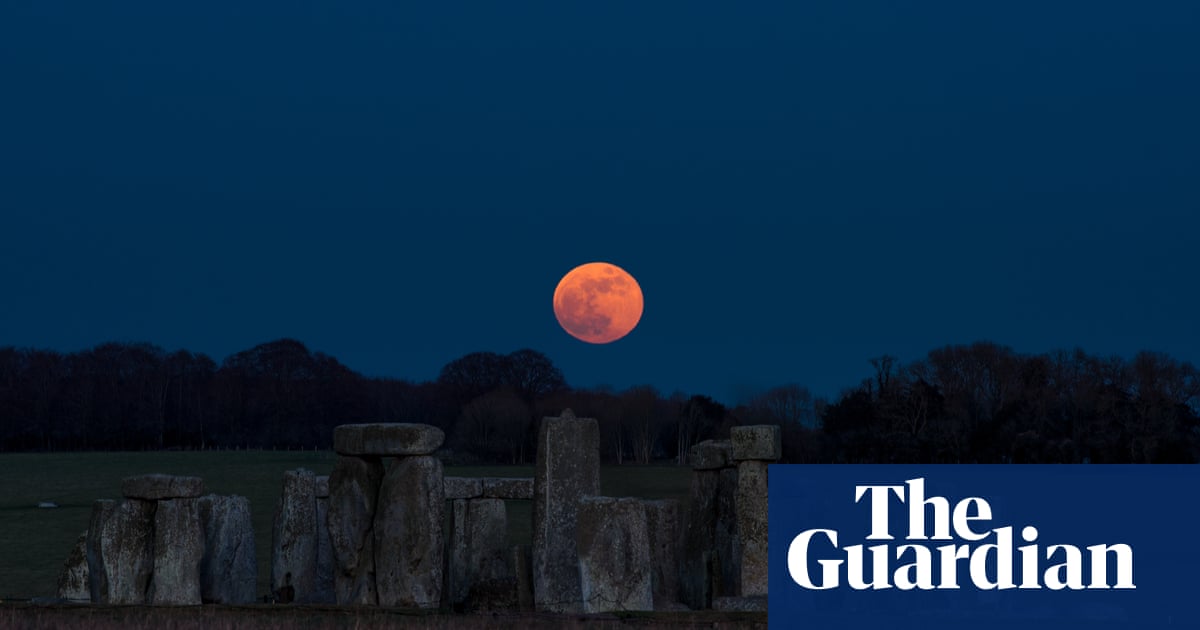It may seem fanciful, but as darkness approached – and with it a vanishingly rare lunar event – it was as if the beasts and birds of Stonehenge sensed something strange was happening.
The song of the skylarks and the flight of the starlings seemed particularly energetic; hares, animals with mythical associations with the moon, walked around the stone circle with a clear purpose; the people gathered at the monument became skittish.
Stonehenge is of course closely linked to the rising and setting of the sun, but it is also increasingly thought that the ancient people who built the circle were also fascinated by the moon – and were aware of a phenomenon taking place now called “great lunar standstill,” something that only occurs once every 18.6 years.
This weekend, archaeologists, astronomers and archaeoastronomers (who study how prehistoric humans responded to the sky) arrived at the time of the full moon to investigate the theory that the makers of Stonehenge may have placed some stones to mark the lunar standstill, when the moon rises and moonset are furthest apart along the horizon.
“It’s very exciting,” says Clive Ruggles, emeritus professor of archaeoastronomy at the University of Leicester. “This is a special night because the moon moves across the sky on the lowest possible path and also because it is full as it does so, so it’s the two things together.”
Ruggles, who was armed with maps, cameras and a theodolite, said the key was four “station stones” that form the corners of a rectangle framing the stone circle. When the moon rises at its southernmost point and sets at its northernmost point, it lines up with the station stones.
“Was this all intentional?” Ruggles asked. “My own idea is that yes, I think people were aware that every 18th or 19th year there were times when you could see the moon rise exceptionally far south and set exceptionally far north, and people knew of it and remembered it.”
Heather Sebire, English Heritage’s senior curator for Stonehenge, said it made sense that Stonehenge’s builders would pay attention to the moon. “They were the first farmers. They must have observed the weather and the seasons. So they would also have looked at the moon.”
Sebire said some of Stonehenge’s bluestones caught the moonlight beautifully, adding: “That may be one of the reasons they used them.” She also explained that during the early phase of Stonehenge, people buried the cremated remains of the dead in a part of the monument that aligned with the station’s stones. “Maybe there’s something in all this,” Sebire said.
Jennifer Wexler, a Stonehenge historian for English Heritage, said the vast nature of the landscape made it a beautiful place to watch not only the falling sun but also the rising moon, especially if it is a large one. “It feels like a kind of see-saw of cosmic entities. It is very powerful.”
Those present felt a sense of kinship with other locations around the world where the full moon’s standstill was observed. Similar cohorts watched it at the Calanais standing stones on the Isle of Lewis in Scotland, at Chimney Rock, Colorado, an ancient Chacoan settlement, and at the Griffith Observatory in Los Angeles.
after newsletter promotion
Modern life encroaches on the Stonehenge phenomenon. Cars and trucks speed past on the A303 and unfortunately a plantation on the horizon obscures the line of sight to the spot on the horizon where the southernmost moon first appears.
Only two of the four station stones are still in place. Markers show where English Heritage thinks the two missing stones were – but some archaeoastronomers think one may be slightly off. A temporary marker – a handbag – was placed where it is believed to have been.
The British weather inevitably has its say too. As moonrise time approached on Friday evening, clouds rolled in and a fine drizzle fell. There was a faint glow over the plantation, but there was no big, awesome moon, which made meaningful measurements difficult.
It wasn’t a disaster. The precise date of the lunar standstill is January 2025 and can be studied for months on both sides.
“It’s a shame the clouds came,” said Fabio Silva, senior lecturer in archaeological modeling at Bournemouth University. “But these things happen. We will have other opportunities. We come back.”
